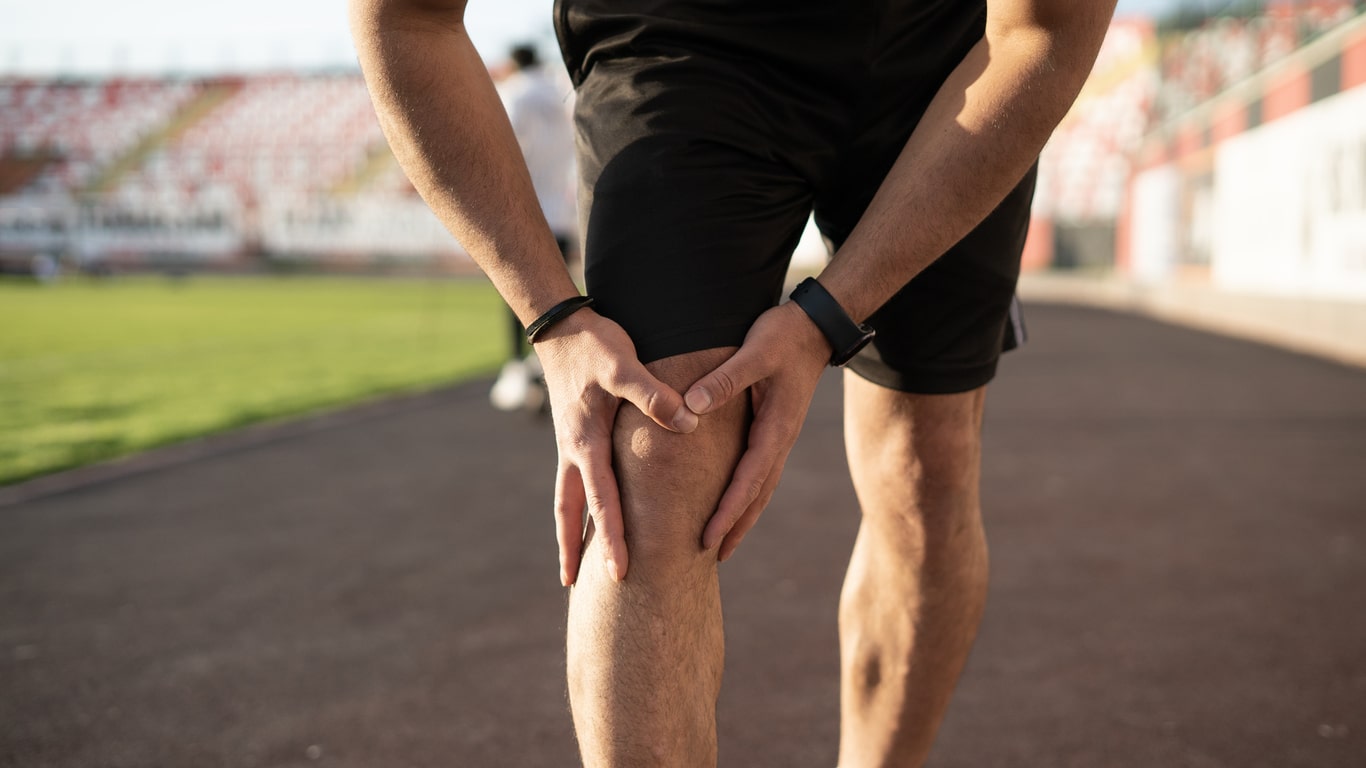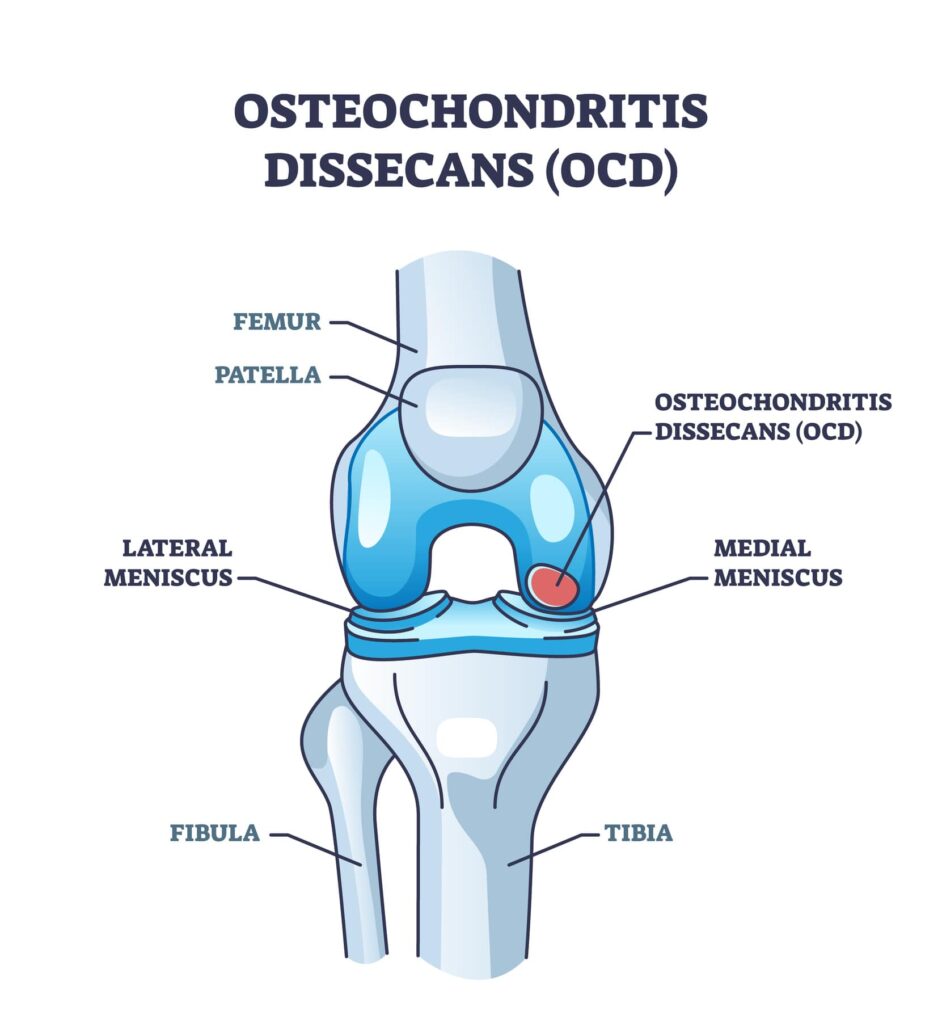Osteochondritis dissecans (OCD) impacts the bones and cartilage in the knee. This can cause pain, swelling, and sometimes joint instability. This condition occurs when a piece of bone or cartilage detaches from the joint, often due to a lack of blood flow or prior injury. While OCD can affect individuals of all ages, it is most common in young, active individuals, particularly athletes. If left untreated, it can cause further joint damage and lead to long-term complications, such as arthritis. Early identification, accurate diagnosis, and timely treatment are key to managing OCD effectively. These steps help manage OCD well and prevent long-term joint problems.
What Is Osteochondritis Dissecans?
Osteochondritis dissecans occurs when the bone and cartilage in a joint become damaged, often due to reduced blood flow to the area. In the knee, this condition can cause the bone and cartilage to crack and sometimes detach from the rest of the joint. It can result in intense pain, swelling, and difficulty moving the joint. OCD is often found in active adolescents and young adults, particularly athletes. The condition may be caused by repeated stress or trauma to the joint. If left untreated, OCD can progress, leading to arthritis or other chronic joint issues.

Causes
Several factors can contribute to the development of osteochondritis dissecans. The most common causes include:
- Repetitive Joint Stress: Running, jumping, or pivoting can stress the knee. This increases the risk of OCD, especially for athletes.
- Previous Injuries: Knee injuries, such as fractures or ligament tears, can disrupt blood flow to the cartilage, leading to OCD.
- Blood Flow Issues: When blood flow to the bone decreases, it can weaken the cartilage. This may cause bone fragments to separate and lead to OCD.
- Genetics: Some people might be more likely to develop OCD because of genes that influence bone and cartilage health.
- Age and Developmental Factors: OCD is often diagnosed in teens and young adults. This condition usually develops while their bones and cartilage are still growing.
Symptoms of Osteochondritis Dissecans
Osteochondritis dissecans can cause a variety of symptoms, which may worsen over time if left untreated. Some common symptoms of OCD include:
- Knee Pain: Persistent pain in the knee joint, especially during physical activity or when putting weight on the knee.
- Swelling and Tenderness: The knee may become swollen, stiff, and tender to the touch, making it difficult to bend or extend fully.
- Locking or Catching Sensation: The knee may feel like it is “locking” or catching during movement due to loose bone or cartilage fragments.
- Limited Range of Motion: Difficulty moving the knee fully, which may impact walking, running, or bending.
- Instability or Weakness: The knee might feel weak or unstable. This can make it hard to bear weight or keep your balance, especially during quick movements or turns.

Diagnosis
To diagnose osteochondritis dissecans (OCD), doctors use physical exams, imaging tests, and sometimes joint fluid analysis. Dr. Howard will begin by reviewing the patient’s medical history and symptoms, then perform a physical exam to check for knee pain, swelling, tenderness, and restricted movement.
Imaging techniques such as X-rays or magnetic resonance imaging (MRI) are commonly used to confirm the diagnosis. X-rays can reveal any bone abnormalities, while MRIs offer a more detailed view of the cartilage and surrounding structures, helping to assess the extent of damage to the bone and cartilage. In some cases, Dr. Howard may recommend an arthroscopy, where a small camera is inserted into the joint to observe the damage and obtain tissue samples if needed.
Treatment Options
Treatment for osteochondritis dissecans (OCD) depends on how severe it is. The goals are to ease pain, improve knee function, and stop more damage to the joint. Consider the following options for treatment:
- Rest and Activity Modification: Reducing physical activity, particularly high-impact sports, to allow the knee to heal and prevent further damage.
- Physical Therapy: Strengthening exercises through physical therapy can improve joint stability, reduce pain, and enhance overall function.
- Medications: Anti-inflammatory medications (NSAIDs) can help manage pain and swelling associated with OCD.
- Bracing or Immobilization: A knee brace or splint can reduce stress on the joint. This limits movement and helps the area heal. This method is often suggested in the early treatment stages. It helps provide stability and limits more damage to the cartilage and bone.
- Surgical Treatment: If the bone or cartilage is badly damaged, surgery might be necessary. This could involve reattaching or removing loose pieces. Sometimes, doctors may replace damaged cartilage with grafts.
Preventing Osteochondritis Dissecans
Some causes of OCD, like genetics, can’t be prevented. But you can take steps to lower your risk of developing OCD or to ease your symptoms:
- Avoid Overuse Injuries: Avoid repetitive high-impact activities that place excessive stress on the knee joint, especially if you are experiencing any knee discomfort.
- Use Proper Technique: Athletes should use proper techniques and protective gear to reduce the risk of knee injury during sports or activities.
- Strengthen Muscles: Maintaining strong leg muscles, particularly the quadriceps (muscles at the front of the thigh), can help stabilize the knee and reduce pressure on the joint.
- Proper Recovery After Injury: If you experience a knee injury, follow recovery protocols, such as rest, ice, compression, and elevation (R.I.C.E.), and seek medical attention if symptoms persist.
- Maintain Overall Joint Health: Maintain a healthy weight and engage in regular exercise to support joint function and flexibility.

Contact Dr. Howard for Treatment
Osteochondritis dissecans is a serious condition. If untreated, it can cause long-term joint damage and other complications. Early recognition and treatment are essential to managing the condition and protecting the health of the knee joint. If you have worries about OCD or feel symptoms like knee pain, swelling, or trouble moving, make an appointment today. Dr. Peter Howard will help guide you through your treatment options, aiming to protect your knee health and restore mobility. Contact us today to schedule an appointment and take the first step toward managing OCD and living an active, pain-free life.
